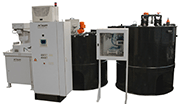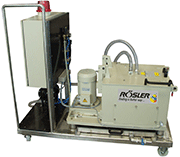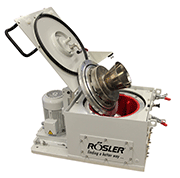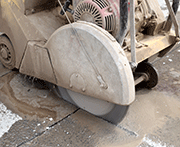E-Archive
Articles
in Vol. 15 - May Issue - Year 2014
Cleaning and Recycling of Industrial Liquids with Centrifuges

Warning sign at Cuyahoga River, Ohio, in the 1960s

Z 1000 with automatic sludge discharge (standard)

For easy use of the centrifuge at machines in different locations, a version with movable base frame is available

A key technical feature of the semi-automatic centrifuges is the rotary drum speed of 3,000 RPM

Cross-section of a 3-phase centrifuge

Usable for many applications: Centrifuges are utilized for removing the tiny stone particles and recycling the process liquid
Ever since in the 1950's and 60's, the Cuyahoga river in Ohio, USA was so polluted that it regularly caught fire, so that protection of the environment including the treatment of waste water and other industrial liquids gained renewed urgency and became an integral part of the industrial landscape. However, it took industry many years to fully accept environmental protection and to embrace it as a business opportunity instead of considering it as a legislated economic burden. The development of centrifugal force filtering equipment for cleaning and recycling of all kinds of industrial liquids is a great example of ecologically responsible behavior going hand-in-hand with saving costs and, at the same time, conserving valuable resources.
The use of water and other liquids is essential for many production processes. Water - in combination with detergents - is used for washing and degreasing of manufactured metal components. Liquids play an important role in all kinds of grinding, cutting and polishing operations. The overspray in paint booths is caught by a water curtain. In addition, cutting fluids are indispensable as coolants and lubricants for metalworking and machining operations.
Why industrial liquids must be cleaned
During their use, industrial liquids are picking up all kinds of contaminants of which the most common ones are solids like metal fines or the fines from abrasive materials as well as oil, grease and other hydrocarbons. As these contaminants accumulate, any industrial liquid loses its functionality. With some production processes, a liquid can only be used once before it must be disposed of, whereas in other instances it can be used multiple times (recycling). In either case, the contaminated liquids must be treated: before being discharged to drain, they must be cleaned to comply with the legal requirements for hazardous material content, or in the case of recycling, they must be cleaned to re-establish their functionality.
Recycling reduces costs and saves valuable resources
There are many methods to remove solid particles from liquids. The simplest one is sedimentation. More sophisticated are chemical flocculation, electroflotation, evaporation, and all kinds of filtering, from simple paper filters to complex membrane filters (ultrafiltration). For the separation of non-emulsified oil from water, skimming devices have been relatively dependable and inexpensive. However, most of these treatment methods are either not very effective or extremely costly, and are frequently rather complicated to operate. Above all, their recycling capabilities are limited. The result is wasteful usage of large quantities of water.
On the other hand, centrifugal force filtering equipment for separating solid particles and - sometimes - oil from industrial liquids has proven to be quite effective and highly economical. As this is primarily a mechanical separation method, the centrifugal force filtering technology allows 100% recycling of the liquids, thus helping to reduce water consumption by up to 97%.
Centrifuges - how they work
At the center is a rotary drum that rotates with a speed of up to 3,000 RPM producing a force of over 2,000 g. In comparison, a merry-go-round produces max. 2 - 4 g (!) The liquid contaminated with solids is pumped into the rotating drum at a constant feed rate. Since the solids have a higher specific weight, they are separated from the liquid and deposited on the inner drum wall in the form of stable sludge with a residual water content of as low as 20%. The centrifugal force is so strong that even tiny solid particles with a size of > 2µm are removed from the liquid. The hydraulic energy in the rotating drum allows a collecting tube to pick up the cleaned water and transport it to an external tank or directly to a user without the need for any pumping equipment.
Depending on the amount of solids in the liquid and the required cleanliness, semi-automatic centrifuges can treat between 100 - 1,200 liters (25 -300 gall.)/h, whereas the capacity of automatic centrifuges ranges from 500 - 3,600 liters (125 - 900 gall.)/h.
At a certain sludge load in the drum (max. 30 kg/48 lbs), the centrifuge is turned off, and the sludge can be removed. In semi-automatic systems this is done by manually removing a basket insert from the drum. Automatic centrifuges are equipped with a knife that automatically peels the sludge from the slowly rotating drum and dumps it into a sludge container below the drum.
3-phase centrifuges
The same physical principle allows not only the removal of solids from liquids but also the separation of liquids with different densities, for example the removal of unwanted oil from coolants. The liquid contaminated with solids and oil is pumped into the rotating drum where the centrifugal force separates the three phases (liquid1/liquid2/solid). The two liquids are picked up and removed from the rotating drum with two separate collecting tubes.
Many cost saving features
Contrary to the highly labor-intensive conventional separation methods like sedimentation, flocculation, electroflotation, evaporation, continuous paper filters, etc., centrifuges are very easy to operate and require no expensive filter materials or chemicals. They run fully automatically without any operator intervention. The removal of the sludge in semi-automatic centrifuges is easy and takes less than 10 minutes. In addition, in the automatic centrifuges even the sludge removal is fully mechanized requiring no labor at all.
Small footprint & easy installation
Due to their compact design, centrifuges require very little space. And they are very easy to install: For example, the semi-automatic centrifuges arrive fully assembled at the customer premises, and once placed at their location, they must only be electrically connected.
Robust rotary drum drive system
Smaller capacity semi-automatic centrifuges are equipped with a direct drive system for the rotary drum running at speeds of up to 3,000 RPM. The automatic centrifuges with considerably larger drum capacities have an indirect drive with V-belt. This allows the installation of precisely sized heavy-duty bearings to absorb the enormous g-forces in the rotary drum.
Innovative sludge peeling mechanism
In traditional automatic centrifuges, the peeling knife rotates with the drum, putting an extra load on the drum bearings. A leading surface finishing equipment manufacturer took a very different technical approach. In his centrifuges, the peeling knife is stationary and completely independent from the drum drive. During the peeling cycle, the knife simply moves pneumatically towards the drum wall to peel out the sludge. This innovative, simple solution results in a much longer uptime of the drum bearings.
Of course, all centrifuges made by this manufacturer are also equipped with an imbalance monitoring system for further protection of the drum bearings.
A wide range of applications
Here are a few examples of successful centrifugal applications:
Process water from mass finishing operations
Due to their technical effectiveness and cost efficiency, during the past 20 years, centrifuges have more or less completely displaced all other treatment systems. In some European countries, chemical or electroflotation systems are no longer approved, if the process water can be cleaned with a centrifuge. This has numerous ecological and economic reasons: Since the cleaned process water is 100% reused, no waste water loaded with all kinds of chemicals must be discharged to drain. Recycling reduces the water usage by about 97% and, as an additional benefit, the chemical compound in the process water is also reclaimed, resulting in a drastically reduced compound usage.
Coolants from machining and metal working operations
In this field, centrifuges have been displacing labor intensive and costly paper filters. The separation of solids down to 2µm contributes to considerably higher uptimes of the coolant and drastically reduces the risk of bacterial contamination.
Washing and degreasing of metal components
These applications are characterized by extremely high surface cleanliness requirements. The pre-cleaning of the washing liquid with a centrifuge greatly enhances the life of the installed fine mesh filters.
Grinding and cutting glass, ceramics, natural stones and concrete
Industrial cutting and grinding operations for glass, ceramics, marble, granite, concrete, etc., require liquids as process coolants and lubricants. Centrifuges are utilized for removing the tiny glass and stone particles and recycling the process liquid.
Painting operations
The overspray in paint booths is caught by a water curtain, before it can escape into the environment. The paint particles accumulating in the water can be quickly removed with a centrifuge in the form of a stable sludge with a residual water content of < 30%, allowing easy discharge to waste.
Numerous applications for centrifuges
The examples described above are just a few of the possible applications for this unique cleaning method. The centrifugal force filtering technology can be used whenever the solid particle contaminants in an industrial liquid have a higher density than the liquid itself; or the contaminant is also a liquid with a different density, for example, oil.
For Information:
Barbara Müller
Rösler Oberflächentechnik GmbH
Vorstadt 1
96190 Untermerzbach, Germany
Tel. +49.9533.924-802
Fax +49.9533.924-300
E-mail: b.mueller@rosler.com
www.rosler.com


























